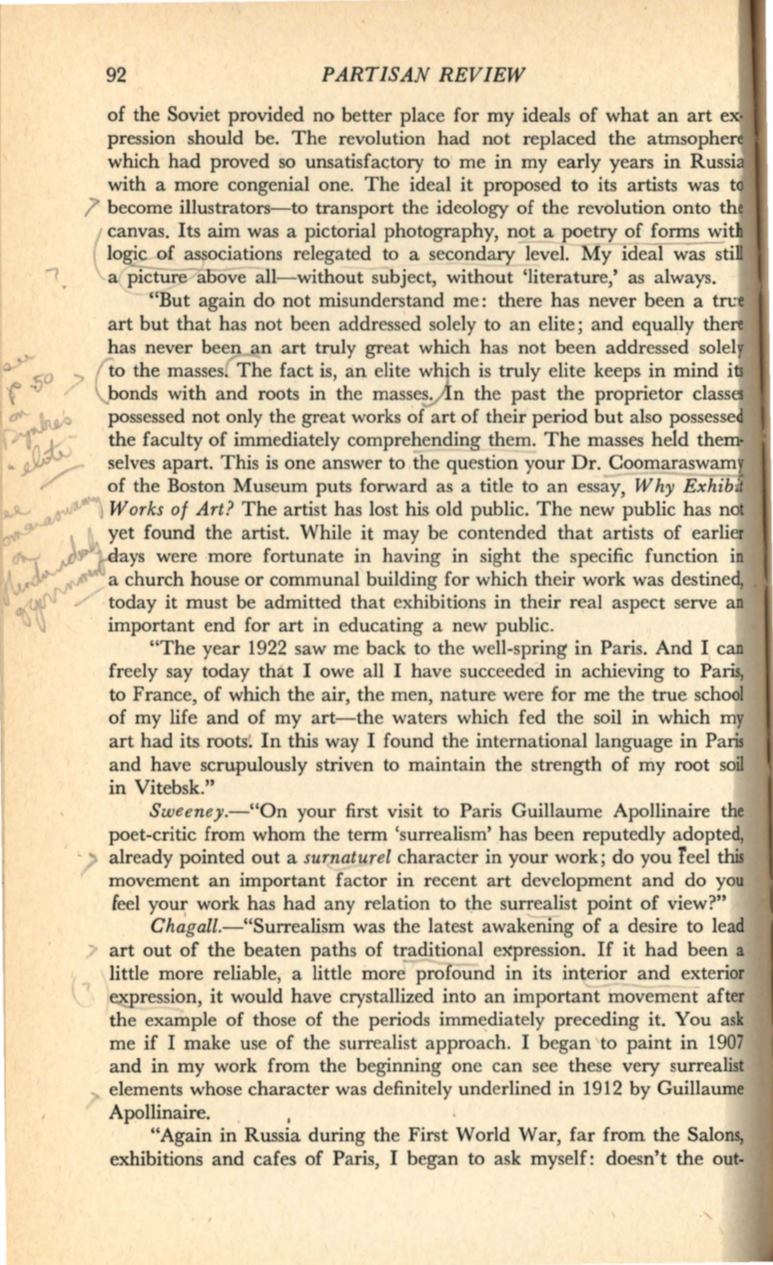
92
PARTISAN REVIEW
of the Soviet provided no better place for my ideals of what an art e
pression should be. The revolution had not replaced the atmsopher
which had proved so unsatisfactory to me in my early years in Russia
with a more congenial one. The ideal it proposed to its artists was to
1
become illustrators-to transport the ideology of the revolution onto the
1
canvas. Its aim was a pictorial photography, not a poetry of forms with
logic of associations relegated to a secondary level. My ideal-was5"tiD
"1
a picture a ove all-without subject, without 'literature,' as always.
"But again do not misunderstand me: there has never been a tn.·e
art but that has not been addressed solely to an elite; and equally there
has never been an art truly great which has not been addressed solely
(
to the masses. The fact
is,
an elite wh"ch is truly elite keeps in mind itJ
bonds with and roots in the masses. n the past the proprietor classa
possessed not only the great works of art of their period but also possessed
the faculty of immediately comprehending them. The masses held them
selves apart. This is one answer to the question your Dr. Coomaraswamy
of the Boston Museum puts forward as a title to an essay,
Why Exhib
Works of Art?
The artist has lost his old public. The new public has not
yet found the artist. While it may be contended that artists of earlier
days were more fortunate in having in sight the specific function in
a church house or communal building for which their work was destined,
today it must be admitted that exhibitions in their real aspect serve an
important end for art in educating a new public.
"The year 1922 saw me back to the well-spring in Paris. And I can
freely say today that I owe all I have succeeded in achieving to Paris,
to France, of which the air, the men, nature were for me the true school
of my life and of my art- the waters which fed the soil in which my
art had its roots: In this way I found the international language in Paris
and have scrupulously striven to maintain the strength of my root soil
in Vitebsk."
Sweeney.-"On
your first visit to Paris Guillaume Apollinaire the
poet-critic from whom the term 'surrealism' has been reputedly adopted,
already pointed out a
surnaturel
character in your work; do you reel
this
movement an important factor in recent art development and do you
feel
you~
work has had any relation to the surrealist point of view?"
Chagall.-"Surrealism was the latest awakening of a desire to lead
art out of the beaten paths of traditional expression.
If
it had been a
little more reliable, a little more profound in its interior and exterior
e~ression,
it would have crystallized into an important movement after
the example of those of the periods immediately preceding it. You ask
me if I make use of the surrealist approach. I began to paint in 1907
and in my work from the beginning one can see these very surrealist
elements whose character was definitely underlined in 1912 by Guillaume
Apollinaire.
,
"Again in Russia during the First World War, far from the Salons,
exhibitions and cafes of Paris, I began to ask myself: doesn't the out-


